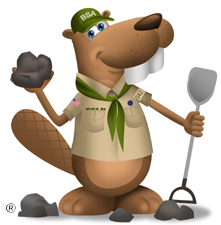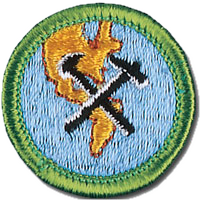Geology


Resources
- Geology Merit Badge Pamphlet
- Geology Merit Badge Workbook - Earth History Option
- Geology Merit Badge Workbook - Energy Resources Option
- Geology Merit Badge Workbook - Mineral Resources Option
- Geology Merit Badge Workbook - Surface and Sedimentary Process Option
- Scoutmaster Bucky's Merit Badge Advancement Quick Reference
- Scoutmaster Bucky's Acknowledgement Form
Related
Geology Requirements
Current Scouts BSA requirements
as of December 16, 2025
as of December 16, 2025
1.
Define geology. Discuss how geologists learn about rock formations. In
geology, explain why the study of the present is important to understanding
the past.
2.
Pick three resources that can be extracted or mined from Earth for
commercial use. Discuss with your counselor how each product is discovered
and processed.
3.
Review a geologic map of your area or an area selected by your counselor,
and discuss the different rock types and estimated ages of rocks
represented. Determine whether the rocks are horizontal, folded, or
faulted, and explain how you arrived at your conclusion.
4.
Do ONE of the following:
a.
With your parent or guardian's and counselor's approval, visit with a
geologist, land use planner, or civil engineer. Discuss this
professional's work and the tools required in this line of work. Learn
about a project that this person is now working on, and ask to see
reports and maps created for this project. Discuss with your counselor
what you have learned.
b.
Find out about three career opportunities available in geology. Pick
one and find out the education, training, and experience required for
this profession. Discuss this with your counselor, and explain why this
profession might interest you.
5.
Do ONE of the following:
a.
Surface and Sedimentary Processes Option
1.
Conduct an experiment approved by your counselor that demonstrates
how sediments settle from suspension in water. Explain to your
counselor what the exercise shows and why it is important.
2.
Using topographical maps provided by your counselor, plot the
stream gradients (different elevations divided by distance) for
four different stream types (straight, meandering, dendritic,
trellis). Explain which ones flow fastest and why, and which ones
will carry larger grains of sediment and why.
3.
On a stream diagram, show areas where you will find the following
features: cut bank, fill bank, point bar, medial channel bars, lake
delta. Describe the relative sediment grain size found in each
feature.
4.
Conduct an experiment approved by your counselor that shows how
some sedimentary material carried by water may be too small for you
to see without a magnifier.
5.
Visit a nearby stream. Find clues that show the direction of water
flow, even if the water is missing. Record your observations in a
notebook, and sketch those clues you observe. Discuss your
observations with your counselor.
b.
Energy Resources Option
1.
List the top five Earth resources used to generate electricity in
the United States.
2.
Discuss source rock, trap, and reservoir rock - the three
components necessary for the occurrence of oil and gas underground.
3.
Explain how each of the following items is used in subsurface
exploration to locate oil or gas: reflection seismic, electric well
logs, stratigraphic correlation, offshore platform, geologic map,
subsurface structure map, subsurface isopach map, and core samples
and cutting samples.
4.
Using at least 20 data points provided by your counselor, create a
subsurface structure map and use it to explain how subsurface
geology maps are used to find oil, gas, or coal resources.
5.
Do ONE of the following:
a.
Make a display or presentation showing how oil and gas or coal
is found, extracted, and processed. You may use maps, books,
articles from periodicals, and research found on the internet
(with your parent or guardian's permission). Share the display
with your counselor or a small group (such as your class at
school) in a five-minute presentation.
b.
With your parent or guardian's and counselor's permission and
assistance, arrange for a visit to an operating drilling rig.
While there, talk with a geologist and ask to see what the
geologist does onsite. Ask to see cutting samples taken at the
site.
c.
Mineral Resources Option
1.
Define rock. Discuss the three classes of rocks including their
origin and characteristics.
2.
Define mineral. Discuss the origin of minerals and their chemical
composition and identification properties, including hardness,
specific gravity, color, streak, cleavage, luster, and crystal
form.
3.
Do ONE of the following:
a.
Collect 10 different rocks or minerals. Record in a notebook
where you obtained (found, bought, traded) each one. Label each
specimen, identify its class and origin, determine its chemical
composition, and list its physical properties. Share your
collection with your counselor.
b.
With your counselor's assistance, identify 15 different rocks
and minerals. List the name of each specimen, tell whether it
is a rock or mineral, and give the name of its class (if it is
a rock) or list its identifying physical properties (if it is a
mineral).
4.
List three of the most common road building materials used in your
area. Explain how each material is produced and how each is used in
road building.
5.
Do ONE of the following:
a.
With your parent or guardian's and counselor's approval, visit
an active mining site, quarry, or sand and gravel pit. Tell
your counselor what you learned about the resources extracted
from this location and how these resources are used by society.
b.
With your counselor, choose two examples of rocks and two
examples of minerals. Discuss the mining of these materials and
describe how each is used by society.
c.
With your parent or guardian's and counselor's approval, visit
the office of a civil engineer and learn how geology is used in
construction. Discuss what you learned with your counselor.
d.
Earth History Option
1.
Create a chart showing suggested geological eras and periods.
Determine which period the rocks in your region might have been
formed.
2.
Explain the theory of plate tectonics. Make a chart explaining, or
discuss with your counselor, how the processes of plate tectonics
work. Discuss how plate tectonics determines the distribution of
most of the Earth's volcanoes, earthquakes, and mountain belts.
3.
Explain to your counselor the processes of burial and
fossilization, and discuss the concept of extinction.
4.
Explain to your counselor how fossils provide information about
ancient life, environment, climate, and geography. Discuss the
following terms and explain how animals from each habitat obtain
food: benthonic, pelagic, littoral, lacustrine, open marine,
brackish, fluvial, eolian, and protected reef.
5.
Collect 10 different fossil plants or animals OR (with your
counselor's assistance) identify 15 different fossil plants or
animals. Record in a notebook where you obtained (found, bought,
traded) each one. Classify each specimen to the best of your
ability, and explain how each one might have survived and obtained
food. Tell what else you can learn from these fossils.
6.
Do ONE of the following:
a.
Visit a science museum or the geology department of a local university
that has fossils on display. With your parent or guardian's and
counselor's approval, before you go, make an appointment with a curator
or guide who can show you how the fossils are preserved and prepared
for display.
b.
Visit a structure in your area that was built using fossiliferous
rocks. Determine what kind of rock was used and tell your counselor the
kinds of fossil evidence you found there.
c.
Visit a rock outcrop that contains fossils. Determine what kind of rock
contains the fossils, and tell your counselor the kinds of fossil
evidence you found at the outcrop.
d.
Prepare a display or presentation on your state fossil. Include an
image of the fossil, the age of the fossil, and its classification. You
may use maps, books, articles from periodicals, and research found on
the internet (with your parent or guardian's permission). Share the
display with your counselor or a small group (such as your class at
school). If your state does not have a state fossil, you may select a
state fossil from a neighboring state.